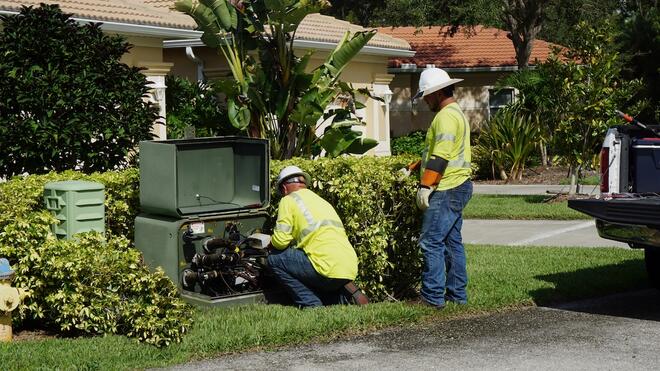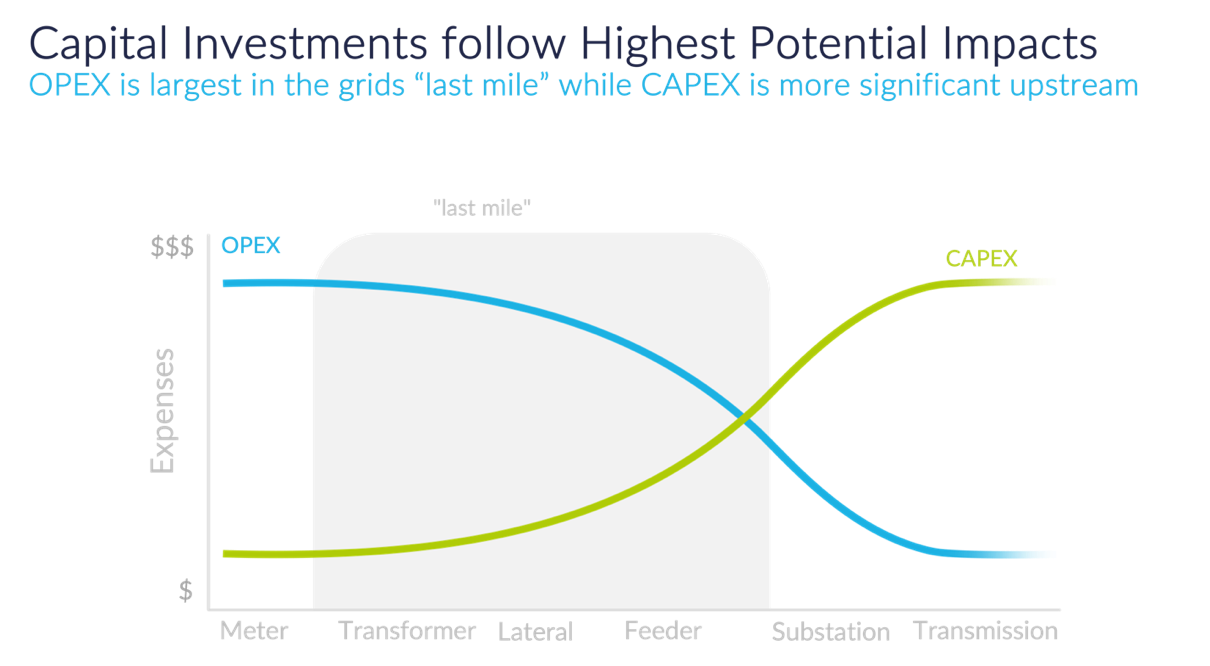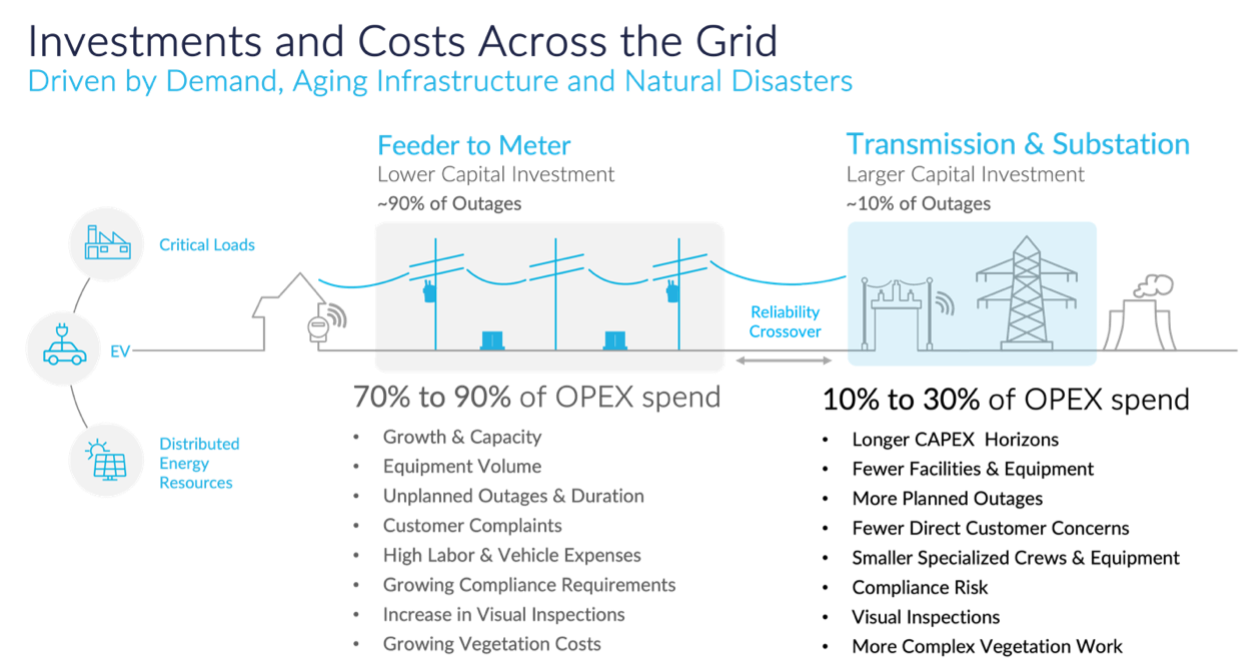Why Last-Mile Investments Are Key to Grid Resilience and Cost Savings

By Dave Herlong
Ubicquia Chief Operating Officer
The electric grid is often called the world’s largest and most complex interconnected machine. It touches every aspect of our lives and drives our digital economy. This is why utilities have invested heavily in the grid’s generation and transmission segments, including Smart Grid technology, to reduce large-scale outages and bolster resilience in extreme weather.
While these investments have paid off, the grid’s distribution infrastructure, the last mile to homes and businesses, has not received comparable funding. As a result, outages occur more frequently (over ninety percent of all outages are in the last mile), restoration costs are higher, and OPEX rises.
This imbalance, which I call the “reliability crossover,” highlights how rising operating costs and outages in last-mile distribution systems are outpacing the benefits of previous investments in generation and transmission. Addressing this crossover requires shifting capital toward last-mile infrastructure, particularly distribution transformer monitoring, enabling utilities to bridge the gap between reliability and cost efficiency.
Figures 1 and 2 demonstrate the impacts of the reliability crossover: rising costs, restoration delays, and growing reliability gaps in distribution networks.


Closing the Gap with Smart Transformer Technology
Utilities have improved last-mile reliability by undergrounding lateral lines, deploying smart meters, and installing sensors and fault detectors. However, a critical component of the last mile—the distribution transformer—remains largely invisible and unmonitored.
Sitting on poles, on the ground, or underground, distribution transformers step down high-voltage electricity for use in homes and businesses. Historically, their high reliability and long lifespan led to a “set and forget” or “run to failure” maintenance approach. But today, supply chain delays and increased demands make this model unsustainable.
By integrating sensors, communications technology, and advanced data analytics, utilities can transform these silent workhorses into active participants in grid management. Smarter transformers provide visibility into:
- Fault detection and isolation: Pinpoint issues quickly to minimize downtime.
- Power diversion and theft: Identify and address losses.
- DER integration: Balance loads from EVs, solar panels, and other distributed energy resources.
- Storm preparation and recovery: Optimize response efforts and improve resilience.
Advanced analytics enable condition-based maintenance, replacing costly manual inspections with targeted interventions. For example, utilities can identify transformers nearing capacity limits or detect vegetation encroachment before it causes damage. These insights reduce truck rolls, lower costs, and improve system reliability.
Boosting Reliability and Customer Satisfaction
Investing in last-mile infrastructure reduces costs and improves customer satisfaction. Utilities can enhance service quality and build stronger customer relationships by addressing reliability issues.
For commercial and industrial clients, power quality is paramount. Smart transformers provide real-time data on load balancing, voltage stability, and harmful harmonics, enabling utilities to support critical operations. This data becomes even more valuable during rate negotiations or planning discussions with high-demand customers like data centers and manufacturers.
Additionally, smarter infrastructure fosters trust by delivering consistent, high-quality power. Residential customers, businesses, and entire communities benefit from fewer outages and faster restoration, creating a more reliable and resilient grid for all.
Transforming the Reliability Crossover
Utilities are at a pivotal moment. They can balance the reliability crossover by prioritizing last-mile distribution systems, mainly through distribution transformer monitoring technology investments. This strategic shift will reduce operating costs and ensure the grid meets modern demands, delivering safe, reliable, high-quality power and fostering strong customer partnerships.
This blog is part of the series Grid Resiliency in a Changing Energy Landscape, written by Dave Herlong. Read the next article in the series: Grid Management Ensures Stability During Disasters – and Everyday

Dave Herlong, Chief Operating Officer, Ubicquia
Dave joins Ubicquia after a distinguished 30-year career at Florida Power & Light Company (FPL). Dave's extensive experience includes leadership roles in Distribution Operations, Construction, Streetlights, Vegetation, Smart Grid and Cyber Resiliency. As Senior Director of FPL's state-of-the-art Control Center and later as Executive Director of Smart Grid and Innovation, Dave played a pivotal role in modernizing the nation's electricity delivery infrastructure. Dave is a 5-time U.S. patent holder, a certified six sigma Black Belt and has earned an Executive Certificate in Strategy & Innovation from M.I.T. At Ubicquia, Dave oversees the daily operations of our Smart Lighting, Smart Grid, and Public Safety business segments.

